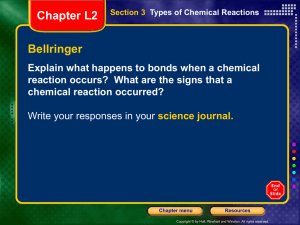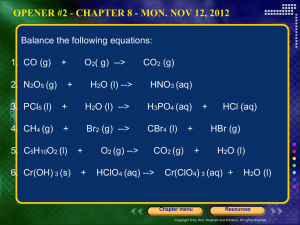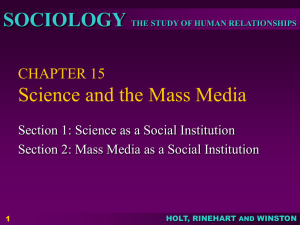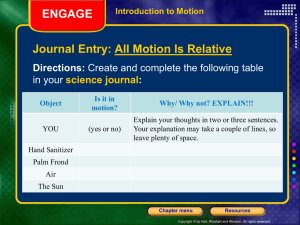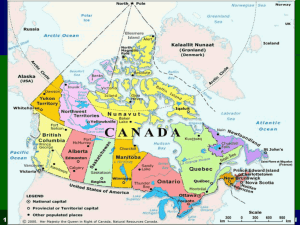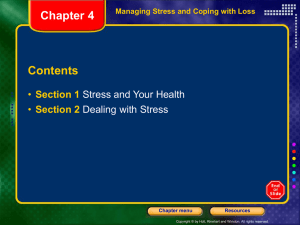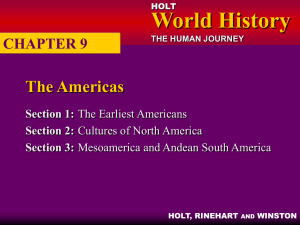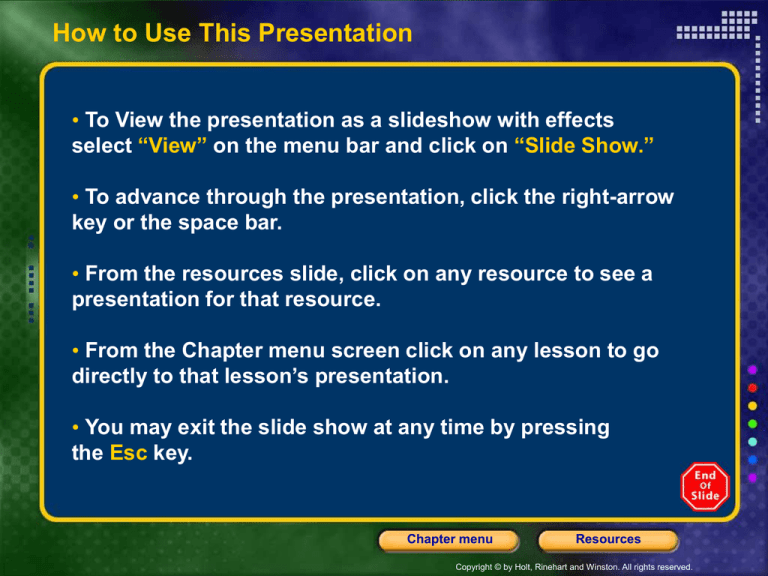
How to Use This Presentation
• To View the presentation as a slideshow with effects
select “View” on the menu bar and click on “Slide Show.”
• To advance through the presentation, click the right-arrow
key or the space bar.
• From the resources slide, click on any resource to see a
presentation for that resource.
• From the Chapter menu screen click on any lesson to go
directly to that lesson’s presentation.
• You may exit the slide show at any time by pressing
the Esc key.
Chapter menu
Resources
Copyright © by Holt, Rinehart and Winston. All rights reserved.
Resources
Bellringers
Chapter Presentation
Transparencies
Standardized Test Prep
Image and Math Focus Bank
CNN Videos
Visual Concepts
Chapter menu
Resources
Copyright © by Holt, Rinehart and Winston. All rights reserved.
Chapter 13
Exploring the Oceans
Table of Contents
Section 1 Earth’s Oceans
Section 2 The Ocean Floor
Section 3 Life in the Ocean
Section 4 Resources from the Ocean
Section 5 Ocean Pollution
Chapter menu
Resources
Copyright © by Holt, Rinehart and Winston. All rights reserved.
Chapter 13
Section 1 Earth’s Oceans
Bellringer
Look at a photo of Earth taken from space. Predict
the percentage of Earth’s surface that is covered
by water.
Write your prediction in your science journal.
Chapter menu
Resources
Copyright © by Holt, Rinehart and Winston. All rights reserved.
Chapter 13
Section 1 Earth’s Oceans
Objectives
• List the major divisions of the global ocean.
• Describe the history of Earth’s oceans.
• Identify the properties of ocean water.
• Describe the interactions between the ocean and
the atmosphere.
Chapter menu
Resources
Copyright © by Holt, Rinehart and Winston. All rights reserved.
Chapter 13
Section 1 Earth’s Oceans
Divisions of the Global Ocean
• The largest ocean is the Pacific Ocean.
• The other oceans, listed from largest to
smallest, are:
• the Atlantic Ocean
• the Indian Ocean
• the Arctic Ocean
Chapter menu
Resources
Copyright © by Holt, Rinehart and Winston. All rights reserved.
Chapter 13
Section 1 Earth’s Oceans
Chapter menu
Resources
Copyright © by Holt, Rinehart and Winston. All rights reserved.
Chapter 13
Section 1 Earth’s Oceans
How Did the Oceans Form?
• About 4.5 billion years ago, there were no oceans.
• Sometime before 4 billion years ago, water vapor in
the atmosphere condensed and fell as rain.
• The rain filled the deeper levels of Earth’s surface
and the first oceans began to form.
Chapter menu
Resources
Copyright © by Holt, Rinehart and Winston. All rights reserved.
Chapter 13
Section 1 Earth’s Oceans
How Did the Oceans Form?, continued
• The shape of the oceans has changed over time.
Chapter menu
Resources
Copyright © by Holt, Rinehart and Winston. All rights reserved.
Chapter 13
Section 1 Earth’s Oceans
Characteristics of Ocean Water
• Dissolved Gases Nitrogen, oxygen, and carbon
dioxide are the main gases dissolved in ocean water.
• Solids Sodium
chloride, or table salt,
is the most abundant
dissolved solid in the
ocean. Other solids are
also found in ocean
water.
Chapter menu
Resources
Copyright © by Holt, Rinehart and Winston. All rights reserved.
Chapter 13
Section 1 Earth’s Oceans
Characteristics of Ocean Water, continued
• Salinity is a measure of the amount of dissolved
solids in a given amount of liquid.
• Changes in Salinity Climate and water movement
affect salinity. Costal water in cool, humid places has
a low salinity. Slow-moving bodies of water have
higher salinity than other parts of the ocean do.
Chapter menu
Resources
Copyright © by Holt, Rinehart and Winston. All rights reserved.
Chapter 13
Section 1 Earth’s Oceans
Chapter menu
Resources
Copyright © by Holt, Rinehart and Winston. All rights reserved.
Chapter 13
Section 1 Earth’s Oceans
Characteristics of Ocean Water, continued
• Temperature Zones The temperature of ocean
water decreases as depth increases.
Chapter menu
Resources
Copyright © by Holt, Rinehart and Winston. All rights reserved.
Chapter 13
Section 1 Earth’s Oceans
Characteristics of Ocean Water, continued
• Surface Temperature Changes Surface-zone
temperatures vary with latitude and the time of year.
• Surface temperatures range from 1ºC near the
poles to about 24 ºC near the equator.
• The surface zone is heated more in the summer.
Chapter menu
Resources
Copyright © by Holt, Rinehart and Winston. All rights reserved.
Chapter 13
Section 1 Earth’s Oceans
The Ocean and the Water Cycle
• The water cycle is the continuous movement of
water from the ocean to the atmosphere to the land
and back to the ocean.
• The ocean is an important part of the water cycle
because nearly all of Earth’s water is in the ocean.
Chapter menu
Resources
Copyright © by Holt, Rinehart and Winston. All rights reserved.
Chapter 13
Section 1 Earth’s Oceans
Chapter menu
Resources
Copyright © by Holt, Rinehart and Winston. All rights reserved.
Chapter 13
Section 1 Earth’s Oceans
A Global Thermostat
• The ocean regulates atmospheric temperatures.
• A Thermal Exchange The ocean absorbs and
releases thermal energy much more slowly than dry
land does.
• The circulation of warm water causes some coastal
lands to have warmer climates than they would have
with the currents.
Chapter menu
Resources
Copyright © by Holt, Rinehart and Winston. All rights reserved.
Chapter 13
Section 2 The Ocean Floor
Bellringer
Pretend you have walked off the edge of North
America and into the depths of the Atlantic Ocean.
As you walk along the ocean floor toward Europe,
what do you see? Draw the ocean floor as you
imagined it.
Illustrate your answer in your science journal.
Chapter menu
Resources
Copyright © by Holt, Rinehart and Winston. All rights reserved.
Chapter 13
Section 2 The Ocean Floor
Objectives
• Describe technologies for studying the ocean floor.
• Identify the two major regions of the ocean floor.
• Classify subdivisions and features of the two major
regions of the ocean floor.
Chapter menu
Resources
Copyright © by Holt, Rinehart and Winston. All rights reserved.
Chapter 13
Section 2 The Ocean Floor
Studying the Ocean Floor
• Seeing by Sonar Scientists use sonar to
determine the ocean’s depth.
• Oceanography via Satellite Scientists use images
from the satellite Seasat to study ocean currents.
• Studying the Ocean with Geosat Scientists use
the Geosat satellite to measure slight changes in the
height of the ocean’s surface.
Chapter menu
Resources
Copyright © by Holt, Rinehart and Winston. All rights reserved.
Chapter 13
Section 2 The Ocean Floor
Chapter menu
Resources
Copyright © by Holt, Rinehart and Winston. All rights reserved.
Chapter 13
Section 2 The Ocean Floor
Revealing the Ocean Floor
• Regions of the Ocean Floor The two regions of
the ocean floor are the continental margin and the
deep-ocean basin.
• Underwater Real Estate The continental margin
and the deep-ocean basin are subdivided into
different areas and have different features, as shown
on the next two slides.
Chapter menu
Resources
Copyright © by Holt, Rinehart and Winston. All rights reserved.
Chapter 13
Section 2 The Ocean Floor
Chapter menu
Resources
Copyright © by Holt, Rinehart and Winston. All rights reserved.
Chapter 13
Section 2 The Ocean Floor
Chapter menu
Resources
Copyright © by Holt, Rinehart and Winston. All rights reserved.
Chapter 13
Section 2 The Ocean Floor
Exploring the Ocean with Underwater
Vessels
• Piloted Vessels: Alvin and Deep Flight Alvin and
Deep Flight are two research vessels that can reach
some of the deepest parts of the ocean.
• Robotic Vessels: JASON II and Medea JASON II
and Medea are a robotic team. JASON II explores
the ocean floor. Medea is attached to JASON II with
a tether and explores above the the sea floor.
Chapter menu
Resources
Copyright © by Holt, Rinehart and Winston. All rights reserved.
Chapter 13
Section 3 Life in the Ocean
Bellringer
Imagine you are a marine biologist who must
classify marine life into three groups. What criteria
would you use in your classification system?
Record your response in your science journal.
Chapter menu
Resources
Copyright © by Holt, Rinehart and Winston. All rights reserved.
Chapter 13
Section 3 Life in the Ocean
Objectives
• Identify the three groups of marine life.
• Describe the two main ocean environments.
• Identify the ecological zones of the benthic and
pelagic environments.
Chapter menu
Resources
Copyright © by Holt, Rinehart and Winston. All rights reserved.
Chapter 13
Section 3 Life in the Ocean
Three Groups of Marine Life
• Organisms that float or drift freely near the ocean’s
surface are called plankton.
• Organisms that swim actively in the open ocean are
called nekton.
• Organisms that live on or in the ocean floor are
called benthos.
Chapter menu
Resources
Copyright © by Holt, Rinehart and Winston. All rights reserved.
Chapter 13
Section 3 Life in the Ocean
Chapter menu
Resources
Copyright © by Holt, Rinehart and Winston. All rights reserved.
Chapter 13
Section 3 Life in the Ocean
The Benthic Environment
• The Benthic Environment is the region near the
bottom of a pond, lake, or ocean.
• The benthic environment is divided into ecological
zones based on where different types of benthos live.
Chapter menu
Resources
Copyright © by Holt, Rinehart and Winston. All rights reserved.
Chapter 13
Section 3 Life in the Ocean
The Benthic Environment, continued
• The Intertidal Zone is where the ocean meets the
land.
• The intertidal zone is exposed to air for part of the
day. Organisms found in this zone include starfish,
sea anemones, barnacles, crabs, and seaweed.
Chapter menu
Resources
Copyright © by Holt, Rinehart and Winston. All rights reserved.
Chapter 13
Section 3 Life in the Ocean
The Benthic Environment, continued
• The Sublittoral Zone The sublittoral zone begins
at the low-tide limit and extends to the continental
shelf, which is about 200 m below sea level.
•The temperature, water pressure, and amount of
sunlight remain fairly constant in this zone. Coral is
found in this zone.
Chapter menu
Resources
Copyright © by Holt, Rinehart and Winston. All rights reserved.
Chapter 13
Section 3 Life in the Ocean
The Benthic Environment, continued
• The Bathyal Zone The bathyal zone extends
from the continental shelf to the abyssal zone. The
depth of this zone ranges from 200 m to 4,000 m
below sea level.
• Because of the lack of sunlight, few plants are
found in this zone. Animals such as sea stars,
sponges, and octopuses are found here.
Chapter menu
Resources
Copyright © by Holt, Rinehart and Winston. All rights reserved.
Chapter 13
Section 3 Life in the Ocean
The Benthic Environment, continued
• The Abyssal Zone The abyssal zone is the
largest ecological zone of the ocean and can reach
4,000 m in depth.
• No plants live in this zone. The few animals that
can be found include crabs, sponges, sea
cucumbers, and worms.
Chapter menu
Resources
Copyright © by Holt, Rinehart and Winston. All rights reserved.
Chapter 13
Section 3 Life in the Ocean
The Benthic Environment, continued
• The Hadal Zone The hadal zone consists of the
floor of the ocean trenches and any organisms
found there. The depth can reach from 6,000 m to
7,000 m below sea level.
• The only organisms that have been found in this
zone include a type of sponge, a few species of
worms, and a type of clam.
Chapter menu
Resources
Copyright © by Holt, Rinehart and Winston. All rights reserved.
Chapter 13
Section 3 Life in the Ocean
The Pelagic Environment
• The zone near the ocean’s surface and at the
middle depths is called the pelagic environment.
• The pelagic environment is above the abyssal
zone and beyond the littoral zone.
•The two major zones of the pelagic environment
are the neritic zone and the oceanic zone.
Chapter menu
Resources
Copyright © by Holt, Rinehart and Winston. All rights reserved.
Chapter 13
Section 3 Life in the Ocean
The Pelagic Environment, continued
• The Neritic Zone The neritic zone is a warm,
shallow zone that covers the continental shelf.
• The neritic zone contains the largest concentration
of marine life.
• The neritic zone receives more sunlight than other
ocean zones, allowing plankton to grow and serve as
a food supply.
Chapter menu
Resources
Copyright © by Holt, Rinehart and Winston. All rights reserved.
Chapter 13
Section 3 Life in the Ocean
The Pelagic Environment, continued
• The Oceanic Zone The oceanic zone includes
the volume of water that covers the entire sea
floor except for the continental shelf.
• The deeper parts of the oceanic zone have
colder water temperatures and much greater
pressure than the neritic zone.
• Organisms are more spread out in the oceanic
zone.
Chapter menu
Resources
Copyright © by Holt, Rinehart and Winston. All rights reserved.
Chapter 13
Section 4 Resources from the Ocean
Bellringer
Tabitha drove her car to the market to buy a tuna
steak for dinner. When she got home, she poured
herself a glass of water, fired up her gas grill, and
cooked the tuna. Identify four of Tabitha’s items or
activities that involve resources obtained from the
sea.
Record your response in your science journal.
Chapter menu
Resources
Copyright © by Holt, Rinehart and Winston. All rights reserved.
Chapter 13
Section 4 Resources from the Ocean
Objectives
• List two ways of harvesting the ocean’s living
resources.
• Identify three nonliving resources in the ocean.
• Describe the ocean’s energy resources.
Chapter menu
Resources
Copyright © by Holt, Rinehart and Winston. All rights reserved.
Chapter 13
Section 4 Resources from the Ocean
Living Resources
• Fishing the Ocean Fish are the larges group of
organisms take from the ocean.
• Farming the Ocean People have begun to raise
ocean fish and other organisms in fish farms to help
meet the demand for seafood.
• Savory Seaweed Many types of seaweed are
harvested from the ocean for use as food.
Chapter menu
Resources
Copyright © by Holt, Rinehart and Winston. All rights reserved.
Chapter 13
Section 4 Resources from the Ocean
Nonliving Resources
• Oil and Natural Gas Oil and natural gas are
used for energy and are found under layers of
impermeable rock.
• Searching for Oil Scientists use seismic
equipment to find oil and natural gas under the
ocean floor.
Chapter menu
Resources
Copyright © by Holt, Rinehart and Winston. All rights reserved.
Chapter 13
Section 4 Resources from the Ocean
Nonliving Resources, continued
• Fresh Water and Desalination Fresh water can
be collected for human use by removing the salt from
ocean water.
•Sea-Floor Minerals Scientists estimate that 15% of
the ocean floor is covered with mineral-rich nodules.
However, mining them is costly and difficult.
•Tidal Energy is energy generated from the
movement of the tides.
Chapter menu
Resources
Copyright © by Holt, Rinehart and Winston. All rights reserved.
Chapter 13
Section 4 Resources from the Ocean
Tidal Energy
Click below to watch the Visual Concept.
Visual Concept
You may stop the video at any time by pressing
the Esc key.
Chapter menu
Resources
Copyright © by Holt, Rinehart and Winston. All rights reserved.
Chapter 13
Section 4 Resources from the Ocean
Nonliving Resources, continued
• Wave Energy The constant motion of waves is a
clean, renewable energy resource.
• Researchers have found certain areas of the world
where wave energy can generate enough electrical
energy to make building power plants worthwhile.
Chapter menu
Resources
Copyright © by Holt, Rinehart and Winston. All rights reserved.
Chapter 13
Section 5 Ocean Pollution
Bellringer
How does ocean pollution affect your life? What
are possible ways you contribute to ocean
pollution in your daily life?
Write your answers in your science journal.
Chapter menu
Resources
Copyright © by Holt, Rinehart and Winston. All rights reserved.
Chapter 13
Section 5 Ocean Pollution
Objectives
• Explain the difference between point-source and
nonpoint-source pollution
• Identify three different types of point-source
pollution.
• Describe what is being done to control ocean
pollution.
Chapter menu
Resources
Copyright © by Holt, Rinehart and Winston. All rights reserved.
Chapter 13
Section 5 Ocean Pollution
Nonpoint-Source Pollution
• Pollution that comes from many sources rather than
from a single site is called nonpoint-source
pollution.
• Most ocean pollution is nonpoint-source pollution
and can be difficult to regulate and control.
Chapter menu
Resources
Copyright © by Holt, Rinehart and Winston. All rights reserved.
Chapter 13
Section 5 Ocean Pollution
Point-Source Pollution
• Trash Dumping Dumping trash in the deeper parts
of the ocean is a common practice in many countries.
• Effects of Trash Dumping Trash thrown in the
ocean can be harmful to ocean organisms.
• Sludge Dumping Sludge is the solid waste
removed from raw sewage. Sludge can pollute
beaches and kill marine life.
Chapter menu
Resources
Copyright © by Holt, Rinehart and Winston. All rights reserved.
Chapter 13
Section 5 Ocean Pollution
Point-Source Pollution, continued
• Oil Spills If not handled properly, oil transports can
cause oil spills.
Chapter menu
Resources
Copyright © by Holt, Rinehart and Winston. All rights reserved.
Chapter 13
Section 5 Ocean Pollution
Point-Source Pollution, continued
• Effects of Oil Spills Oil spills can harm or kill
many plants and animals.
• Preventing Oil Spills New technology is being
used to safeguard against oil spills. Oil tankers are
now being built with two hulls instead of one.
Chapter menu
Resources
Copyright © by Holt, Rinehart and Winston. All rights reserved.
Chapter 13
Section 5 Ocean Pollution
Saving Our Ocean Resources
• Nations Take Notice Many international
agreements and laws restrict ocean pollution.
• Citizens Taking Charge People have demanded
that their governments work to solve ocean pollution
and have begun organizing beach cleanups.
• Action in the United States The U.S. has passed
laws to control local pollution.
Chapter menu
Resources
Copyright © by Holt, Rinehart and Winston. All rights reserved.
Chapter 13
Exploring the Oceans
Concept Map
Use the terms below to complete the concept map
on the next slide.
ecological zones
benthos
intertidal zone
benthic zone
nentic zone
marine life
oceans
plankton
oceanic zone
Chapter menu
Resources
Copyright © by Holt, Rinehart and Winston. All rights reserved.
Chapter 13
Exploring the Oceans
Chapter menu
Resources
Copyright © by Holt, Rinehart and Winston. All rights reserved.
Chapter 13
Exploring the Oceans
Chapter menu
Resources
Copyright © by Holt, Rinehart and Winston. All rights reserved.
End of Chapter 13 Show
Chapter menu
Resources
Copyright © by Holt, Rinehart and Winston. All rights reserved.
Chapter 13
Exploring the Oceans
CNN Videos
• Multicultural Connections: Saving Pacific Sea
Horses
• Scientists in Action: Deep Flight
• Scientists in Action: Studying Dolphin Behavior
Chapter menu
Resources
Copyright © by Holt, Rinehart and Winston. All rights reserved.
Chapter 13
Standardized Test Preparation
Reading
Read each of the passages. Then, answer the
questions that follow each passage.
Chapter menu
Resources
Copyright © by Holt, Rinehart and Winston. All rights reserved.
Chapter 13
Standardized Test Preparation
Passage 1 Because oil is in such high demand across
the world, large tankers must transport billions of
barrels of it across the oceans. If not handled properly,
these transports can quickly turn disastrous. In 1989,
the supertanker Exxon Valdez struck a reef and spilled
more than 260,000 barrels of crude oil. The effect of
this accident on wildlife was catastrophic.
Continued on the next slide
Chapter menu
Resources
Copyright © by Holt, Rinehart and Winston. All rights reserved.
Chapter 13
Standardized Test Preparation
Passage 1, continued Within the first few weeks of the
Exxon Valdez oil spill, more than half a million birds,
including 109 endangered bald eagles, were covered
with oil and drowned. Almost half the sea otters in the
area also died, either from drowning or from being
poisoned by the oil. Alaskans who made their living
from fishing lost their businesses. Although many
animals were saved and the Exxon Oil Company spent
$2.1 billion to clean up the mess, Alaska’s wildlife and
economy will continue to suffer for decades.
Chapter menu
Resources
Copyright © by Holt, Rinehart and Winston. All rights reserved.
Chapter 13
Standardized Test Preparation
1. What is the main idea of this passage?
A Transporting oil over long distances is difficult.
B The Exxon Oil Company did a great job of cleaning
up the oil spill in Alaska.
C Oil spills such as the Exxon Valdez spill can create
huge problems.
D Alaska’s economy will suffer because so much oil
was lost.
Chapter menu
Resources
Copyright © by Holt, Rinehart and Winston. All rights reserved.
Chapter 13
Standardized Test Preparation
1. What is the main idea of this passage?
A Transporting oil over long distances is difficult.
B The Exxon Oil Company did a great job of cleaning
up the oil spill in Alaska.
C Oil spills such as the Exxon Valdez spill can create
huge problems.
D Alaska’s economy will suffer because so much oil
was lost.
Chapter menu
Resources
Copyright © by Holt, Rinehart and Winston. All rights reserved.
Chapter 13
Standardized Test Preparation
2. In the passage, which of the following problems was
said to be a result of the Exxon Valdez oil spill?
F The beach became too slippery to walk on.
G Many people in Alaska had no oil for their cars.
H Exxon had to build a new tanker.
I Many Alaskan fishers lost their businesses.
Chapter menu
Resources
Copyright © by Holt, Rinehart and Winston. All rights reserved.
Chapter 13
Standardized Test Preparation
2. In the passage, which of the following problems was
said to be a result of the Exxon Valdez oil spill?
F The beach became too slippery to walk on.
G Many people in Alaska had no oil for their cars.
H Exxon had to build a new tanker.
I Many Alaskan fishers lost their businesses.
Chapter menu
Resources
Copyright © by Holt, Rinehart and Winston. All rights reserved.
Chapter 13
Standardized Test Preparation
Passage 2 Whales, dolphins, and porpoises are
mammals that belong to the order Cetacea (suh TAY
shuh). Cetaceans live throughout the global ocean.
They have fishlike bodies and forelimbs called flippers.
Cetaceans lack hind limbs but have broad, flat tails
that help them swim through the water. Cetaceans
breathe through blowholes located on the top of the
head. They are completely hairless except for a few
bristles on their snout.
Continued on the next slide
Chapter menu
Resources
Copyright © by Holt, Rinehart and Winston. All rights reserved.
Chapter 13
Standardized Test Preparation
Passage 2, continued A thick layer of blubber below
the skin helps insulate cetaceans against cold
temperatures. Cetaceans are divided into two groups:
toothed whales and baleen whales. Toothed whales
include sperm whales, beluga whales, narwhals, killer
whales, dolphins, and porpoises. Baleen whales, such
as blue whales, lack teeth. They filter food from the
water by using a meshlike net of baleen that hangs
from the roof of their mouth.
Chapter menu
Resources
Copyright © by Holt, Rinehart and Winston. All rights reserved.
Chapter 13
Standardized Test Preparation
1. How are organisms that make up the order Cetacea
divided?
A They are divided into cetaceans that have hair and
cetaceans that do not have hair.
B They are divided into cetaceans that have flippers
and cetaceans that do not have flippers.
C They are divided into cetaceans that have blowholes
and cetaceans that do not have blowholes.
D They are divided into cetaceans that have teeth and
cetaceans that do not have teeth.
Chapter menu
Resources
Copyright © by Holt, Rinehart and Winston. All rights reserved.
Chapter 13
Standardized Test Preparation
1. How are organisms that make up the order Cetacea
divided?
A They are divided into cetaceans that have hair and
cetaceans that do not have hair.
B They are divided into cetaceans that have flippers
and cetaceans that do not have flippers.
C They are divided into cetaceans that have blowholes
and cetaceans that do not have blowholes.
D They are divided into cetaceans that have teeth and
cetaceans that do not have teeth.
Chapter menu
Resources
Copyright © by Holt, Rinehart and Winston. All rights reserved.
Chapter 13
Standardized Test Preparation
2. Which of the following statements lists
characteristics of all cetaceans?
F Cetaceans have fur and claws and live in rivers.
G Cetaceans have flippers and bristles on the snout
and live in oceans.
H Cetaceans have blowholes and flippers and live
in lakes.
I Cetaceans have fur, bristles on the snout, and
flippers.
Chapter menu
Resources
Copyright © by Holt, Rinehart and Winston. All rights reserved.
Chapter 13
Standardized Test Preparation
2. Which of the following statements lists
characteristics of all cetaceans?
F Cetaceans have fur and claws and live in rivers.
G Cetaceans have flippers and bristles on the snout
and live in oceans.
H Cetaceans have blowholes and flippers and live
in lakes.
I Cetaceans have fur, bristles on the snout, and
flippers.
Chapter menu
Resources
Copyright © by Holt, Rinehart and Winston. All rights reserved.
Chapter 13
Standardized Test Preparation
Interpreting Graphics
Use the image of the ocean floor below to answer the
questions that follow.
Chapter menu
Resources
Copyright © by Holt, Rinehart and Winston. All rights reserved.
Chapter 13
Standardized Test Preparation
1. At which point are two
tectonic plates separating?
A1
B2
C3
D4
Chapter menu
Resources
Copyright © by Holt, Rinehart and Winston. All rights reserved.
Chapter 13
Standardized Test Preparation
1. At which point are two
tectonic plates separating?
A1
B2
C3
D4
Chapter menu
Resources
Copyright © by Holt, Rinehart and Winston. All rights reserved.
Chapter 13
Standardized Test Preparation
2. Which point shows an
ocean trench?
F1
G2
H3
I 4
Chapter menu
Resources
Copyright © by Holt, Rinehart and Winston. All rights reserved.
Chapter 13
Standardized Test Preparation
2. Which point shows an
ocean trench?
F1
G2
H3
I 4
Chapter menu
Resources
Copyright © by Holt, Rinehart and Winston. All rights reserved.
Chapter 13
Standardized Test Preparation
3. Which feature might
eventually become a
volcanic island?
A1
B2
C3
D4
Chapter menu
Resources
Copyright © by Holt, Rinehart and Winston. All rights reserved.
Chapter 13
Standardized Test Preparation
3. Which feature might
eventually become a
volcanic island?
A1
B2
C3
D4
Chapter menu
Resources
Copyright © by Holt, Rinehart and Winston. All rights reserved.
Chapter 13
Standardized Test Preparation
4. Which features are part
of the deep-ocean basin?
F 2, 3, and 4
G 1, 2, and 3
H 1, 3, and 4
I 1, 2, and 4
Chapter menu
Resources
Copyright © by Holt, Rinehart and Winston. All rights reserved.
Chapter 13
Standardized Test Preparation
4. Which features are part
of the deep-ocean basin?
F 2, 3, and 4
G 1, 2, and 3
H 1, 3, and 4
I 1, 2, and 4
Chapter menu
Resources
Copyright © by Holt, Rinehart and Winston. All rights reserved.
Chapter 13
Standardized Test Preparation
5. Which feature is part of
the continental margin?
A1
B2
C3
D4
Chapter menu
Resources
Copyright © by Holt, Rinehart and Winston. All rights reserved.
Chapter 13
Standardized Test Preparation
5. Which feature is part of
the continental margin?
A1
B2
C3
D4
Chapter menu
Resources
Copyright © by Holt, Rinehart and Winston. All rights reserved.
Chapter 13
Standardized Test Preparation
Math
Read each question, and choose the best answer.
Chapter menu
Resources
Copyright © by Holt, Rinehart and Winston. All rights reserved.
Chapter 13
Standardized Test Preparation
1. Imagine that you are in the kelp-farming business
and your kelp grows 33 cm per day. You begin
harvesting when your plants are 50 cm tall. During the
first 7 days of harvest, you cut 10 cm off the top of your
kelp plants each day. How tall will your kelp plants be
after the seventh day of harvesting?
A 80 cm
B 130 cm
C 210 cm
D 211 cm
Chapter menu
Resources
Copyright © by Holt, Rinehart and Winston. All rights reserved.
Chapter 13
Standardized Test Preparation
1. Imagine that you are in the kelp-farming business
and your kelp grows 33 cm per day. You begin
harvesting when your plants are 50 cm tall. During the
first 7 days of harvest, you cut 10 cm off the top of your
kelp plants each day. How tall will your kelp plants be
after the seventh day of harvesting?
A 80 cm
B 130 cm
C 210 cm
D 211 cm
Chapter menu
Resources
Copyright © by Holt, Rinehart and Winston. All rights reserved.
Chapter 13
Standardized Test Preparation
2. A sample of ocean water contains 36 g of dissolved
solids per 1,000 g of water. So, how many grams of
dissolved solids will be in 4 kg of ocean water?
F 36,000 g
G 360 g
H 250 g
I 144 g
Chapter menu
Resources
Copyright © by Holt, Rinehart and Winston. All rights reserved.
Chapter 13
Standardized Test Preparation
2. A sample of ocean water contains 36 g of dissolved
solids per 1,000 g of water. So, how many grams of
dissolved solids will be in 4 kg of ocean water?
F 36,000 g
G 360 g
H 250 g
I 144 g
Chapter menu
Resources
Copyright © by Holt, Rinehart and Winston. All rights reserved.
Chapter 13
Standardized Test Preparation
3. If the average depth of the Pacific Ocean is
4,250 m and the average depth of the Atlantic
Ocean is 4,000 m, what is the average depth
of the two oceans?
A 4,250 m
B 4,150 m
C 4,125 m
D 4,000 m
Chapter menu
Resources
Copyright © by Holt, Rinehart and Winston. All rights reserved.
Chapter 13
Standardized Test Preparation
3. If the average depth of the Pacific Ocean is
4,250 m and the average depth of the Atlantic
Ocean is 4,000 m, what is the average depth
of the two oceans?
A 4,250 m
B 4,150 m
C 4,125 m
D 4,000 m
Chapter menu
Resources
Copyright © by Holt, Rinehart and Winston. All rights reserved.
Chapter 13
Standardized Test Preparation
4. Alvin, a minisub, starts at –300 m, then rises 20 m,
then drops 150 m, and finally reaches the ocean floor
by dropping another 218 m. At what depth is Alvin
when it reaches the ocean floor?
F –648 m
G –88 m
H 88 m
I 648 m
Chapter menu
Resources
Copyright © by Holt, Rinehart and Winston. All rights reserved.
Chapter 13
Standardized Test Preparation
4. Alvin, a minisub, starts at –300 m, then rises 20 m,
then drops 150 m, and finally reaches the ocean floor
by dropping another 218 m. At what depth is Alvin
when it reaches the ocean floor?
F –648 m
G –88 m
H 88 m
I 648 m
Chapter menu
Resources
Copyright © by Holt, Rinehart and Winston. All rights reserved.
Chapter 13
Standardized Test Preparation
5. The speed of sound in water is 1,500 m/s. How far
will sound travel in water in 1 min?
A 25 m
B 1,500 m
C 9,000 m
D 90,000 m
Chapter menu
Resources
Copyright © by Holt, Rinehart and Winston. All rights reserved.
Chapter 13
Standardized Test Preparation
5. The speed of sound in water is 1,500 m/s. How far
will sound travel in water in 1 min?
A 25 m
B 1,500 m
C 9,000 m
D 90,000 m
Chapter menu
Resources
Copyright © by Holt, Rinehart and Winston. All rights reserved.
Chapter 13
Section 1 Earth’s Oceans
Chapter menu
Resources
Copyright © by Holt, Rinehart and Winston. All rights reserved.
Chapter 13
Section 1 Earth’s Oceans
Chapter menu
Resources
Copyright © by Holt, Rinehart and Winston. All rights reserved.
Chapter 13
Section 1 Earth’s Oceans
Chapter menu
Resources
Copyright © by Holt, Rinehart and Winston. All rights reserved.
Chapter 13
Section 3 Life in the Ocean
Chapter menu
Resources
Copyright © by Holt, Rinehart and Winston. All rights reserved.
Chapter 13
Section 3 Life in the Ocean
Chapter menu
Resources
Copyright © by Holt, Rinehart and Winston. All rights reserved.
Chapter 13
Section 5 Ocean Pollution
Chapter menu
Resources
Copyright © by Holt, Rinehart and Winston. All rights reserved.
Chapter 13
Standardized Test Preparation
Chapter menu
Resources
Copyright © by Holt, Rinehart and Winston. All rights reserved.

